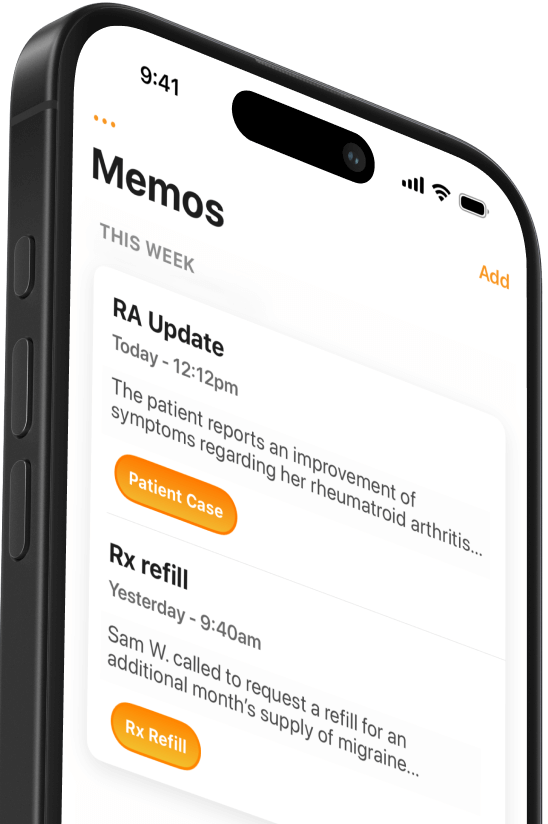Should you use a smartphone app or dictaphone for medical dictation?
Medical dictation using speech-to-text streamlines documentation. Should you use a smartphone app or traditional dictaphone? Find out which option works best.


Popular articles
Medical dictation using speech-to-text software is an effective way to streamline clinical documentation. But until recently, if you wanted to dictate medical notes on your work computer or laptop, you needed to plug in a separate microphone. Technology is changing fast, so you might be wondering: Should I use a smartphone app or dictaphone for medical dictation?
Dictaphones: the traditional way
Dictaphones have been valuable business tools for decades. Ten years ago, they were the only reliable way to dictate clinical notes or other professional recordings for later transcription.
With early dictaphones, a physician would record their dictation on the device, and a transcriptionist would listen to the recording and type the note. But as technology progressed, automating transcription using AI-powered speech-to-text software became more common.
If you previously dictated clinical notes, you likely used a dictaphone, which looked like a TV remote and plugged into your computer with a USB cable. The dictaphone either recorded the dictation for asynchronous transcription or connected to a voice recognition software that transcribed it in real-time.
Today, there is an easier way. Every doctor already has a more powerful dictation machine in their pocket: the smartphone.
Smartphones are an easy replacement for dictaphones
As recently as a few years ago, technology experts recommended a dictaphone over a smartphone app for medical dictation. They would have said that dictaphones have longer battery life, better sound quality, are easier to use, and have more features than a smartphone app.
But that’s no longer the reality. For example, consider these specs for modern smartphones like the iPhone 14 Pro and the Samsung Galaxy S23 Ultra:
- Battery Life: Both the iPhone 14 Pro and the Galaxy S23 Ultra have batteries that last 20-40 hours with active use. That’s up to two shifts at the hospital on a single charge, even if you’re using your device frequently.
- Sound Quality: Most doctors aren’t concerned about good quality as long as their recordings are audible. Still, smartphones have excellent sound quality that accurately captures your voice recordings, even in loud environments.
- Storage: New smartphones typically include at least 128GB of memory, with options for much more. That's plenty of storage for thousands of hours of audio recordings. Besides, most medical dictation software now stores recordings directly in the cloud, making device storage a non-issue.
- User Interface: Smartphones are one of the most carefully designed consumer products and far more intuitive than any dictaphone. Besides, doctors are already comfortable using their smartphones for non-work purposes. That means transitioning to a smartphone dictation app typically requires no training or user manual.
- Features: All modern smartphones come with built-in speech-to-text capabilities (whether Google or Siri) and voice recording apps (Voice Memos in Apple and Voice Recorder in Android). And with hundreds of medical dictation apps on the market, there’s no limit to features available for dictation and transcription.
Benefits of medical dictation apps
As you probably see, modern smartphones have all the technical requirements necessary to replace a traditional dictaphone. And with the right mobile dictation app, they offer a few obvious benefits.
Let’s use the example of Mobius Conveyor, one popular dictation software that works on Mac and PC.
Always with you
Unlike a dictaphone, you always have your smartphone. Whether you want to dictate into an app on your desktop or directly into the EMR from your smartphone, Conveyor makes it easy.
Apps like Mobius Conveyor also allow you to record voice memos to insert into the EMR later. So if you change workstations, work from home, or want to dictate clinical notes in the car, you don’t have to wait. Smartphones offer a convenient mobile dictation solution that never leaves your side.
Instant and accurate
Depending on your dictation and transcription workflow, a dictaphone may create lag times before completing your clinical notes. Mobile medical dictation uses voice recognition software, so your words appear on the screen as you speak.
Apps like Mobius Conveyor use deep learning and neural net technology to provide the most accurate voice recognition software on the planet. Conveyor gets even better as you use it, and like most medical dictation apps, it understands medical terminology out of the box.
EMR integrated
Making medical dictation efficient requires integrating it carefully into your clinical documentation workflow.
Mobile apps like Mobius Conveyor connect directly to the EMR and instantly save your dictation in the right place.
Should you use a smartphone app or dictaphone?
Busy doctors looking for efficiency and simplicity will find that a mobile app on their smartphone is the easiest way to dictate clinical notes.
As hospitals integrate smartphones more thoroughly, healthcare will likely phase out dictaphones. But physicians don’t have to wait. If you’re looking for an easy way to dictate clinical notes on any computer, look no further than the smartphone in your pocket.

Related Articles


We Get Doctors Home on Time.
Contact us
We proudly offer enterprise-ready solutions for large clinical practices and hospitals.
Whether you’re looking for a universal dictation platform or want to improve the documentation efficiency of your workforce, we’re here to help.





